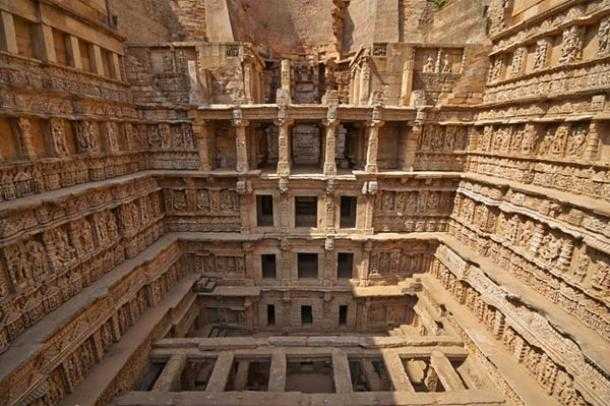
History of Rani Ka Vav
It is believed that this grand structure was commissioned by the widowed queen Udaymati in the fond memory of her husband Bhimdev I (AD 1022 to 1063), son of Mularaja, the founder of the Solanki dynasty of Anahilwada Pattan. The construction started around 1050 AD and was probably completed by Udayamati and Karandev I after the death of her husband. One can find the reference of Udayamati building the monument in the 'Prabandha Chintamani' composed by Merunga Suri in 1304 AD. Later, the vav was flooded by River Saraswati located nearby and silted over until the 1980s. It was then that Archaeological Survey of India excavated it along with its carvings in pristine condition. Today, considered as a man-made marvel, Rani ka Vav is among the finest step wells in the legacies of the ancient capital city of Patan.
Architecture Rani Ka Vav
Rani ka Vav cited as one of the spectacular pieces of architecture, reflects the typical Maru-Gurjara architectural style. It exhibits intricate technique and admiring the beauty of details and proportion achieved. Originally built as a memorial in the 11th century, this step well apart from having sound water sourcing and structural stability is also a piece of true artistic mastery.
The well is separated into seven level of stairs adorned with sculptural panels of high artistic quality along with more than five hundred principal sculptures and over a thousand other religious and mythological figures, often referencing literary works. Oriented in the east-west direction, the fourth level, which is the deepest leads to a rectangular tank (9.5 metres by 9.4 metres) at a depth of 23 metres. The well also holds religious significance and thus is designed as an inverted temple highlighting the sanctity of water. A number of stone structures depicting the various 'avatars' or manifestations of Lord Vishnu such as Kalki, Rama, Krishna, Narsinh, Vaman, Varahi can be seen here. Interestingly, the sculptures of various Yoginis and Apsaras can be seen here sporting the 'Solah - Shringar' or 16 different styles of ornamentation of oneself.
Significance of Rani ka Vav
The vavs of Gujarat, apart from being the site of collecting water and socialising, were also of great spiritual importance in the past. Although initially, the design of these wells leaned more towards a simplistic design, over time these styles became more complex and intricate. This was done mainly to emphasise on the sanctity of the water being stored in the vav. Rani Ki Vav is one such example that gives a feel of a subterranean temple on entering.
The most emphatic pieces of embellishment here have to be the statues and sculptures of Lord Vishnu. The general theme of Rani Ki Vav is 'Dashavatars' or the ten incarnations of the deity. The well descends to sub - terranean levels where you can observe around 800 distinct sculptures spread over seven galleries. The incarnations of Lord Vishnu, namely, Matsya, Kurma, Varaha, Narasimha, Vamana, Parashurama, Rama, Krishna, Buddha, and Kalki are accompanied by statues of sadhus, Brahmins and celestial dancers or 'Apsaras'. The most imposing imagery here is present at the water level of the Rani ki Vav, where you can see Vishnu reclining on the thousand-hooded serpent Shesha.
Best time to visit Rani ki Vav
If you are planning to visit this architectural wonder of Gujarat, plan your trip between October and March when the weather is quite pleasant.
How to Reach Rani ki Vav
The best way to reach the Rani ka Vav is through taxi which is quite convenient. One can also visit by public buses. If you plan on taking the bus, a number of intercity buses run from Ahmedabad to Patan and take approximately 3.5 hours to reach. Buses from Mehsana to Patan take about an hour. Shared jeeps are available as well, and they are slightly quicker but less comfortable.
Top Tourist Places in Patan
Temples
Sahastralinga Talav
Patola Saree making unit
Shopping in Patan
All Tourist Places in Patan
Tips
During the month of December or January, a Rani ka Vav festival is held where one can enjoy the cultural program along with exquisite local cuisine and street shopping.
Photos of Rani ki Vav
Comments on Rani ki Vav
Post Your Comment













